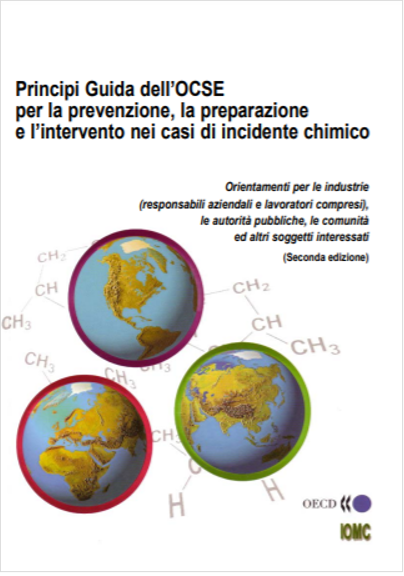Principi Guida nei casi di incidente chimico OCSE / OECD
| Appunti Chemicals | ||
| 27 Novembre 2024 | ||
| Salve Visitatore | ||
|
Principi Guida nei casi di incidente chimico OCSE / OECD Principi Guida dell’OCSE per la prevenzione, la preparazione e l’intervento nei casi di incidente chimico Orientamenti per le industrie (responsabili aziendali e lavoratori compresi), le autorità pubbliche, le comunità ed altri soggetti interessati Questa seconda edizione dei Principi Guida dell’OCSE per la prevenzione la preparazione e l’intervento nei casi di incidente chimico è stata elaborata da un Gruppo di Estensori operante sotto gli auspici del Gruppo di Lavoro sugli Incidenti Chimici che cura il Programma OCSE sugli Incidenti Chimici. La formulazione di questi Principi Guida è stata intrapresa in cooperazione con altre organizzazioni internazionali operanti nell’ambito della prevenzione, preparazione e intervento nei casi di incidente chimico, tra cui l’Organizzazione Internazionale del Lavoro (ILO), l’Organizzazione Marittima Internazionale (IMO), la Commissione Economica per l’Europa delle NU (UNECE), il Programma delle NU per l’Ambiente (UNEP), l’Unità congiunta per l’Ambiente e gli Affari umanitari UNEP/OCHA (UNOCHA), e l’Organizzazione Mondiale della Sanità (WHO). EN Version The Guiding Principles for Chemical Accident Prevention, Preparedness and Response address issues related to: - preventing the occurrence of incidents involving hazardous substances; These principles provide advice to public authorities, industry, employees and their representatives as well as members of the public potentially affected in the event of an accident, and non-governmental organisations. The Guiding Principles apply to all hazardous installations, i.e. fixed plants or sites that produce, process, use, handle, store or dispose of hazardous substances where there is a risk of an accident involving the hazardous substance(s). The Principles also apply to transfer facilities where hazardous substances are loaded and/or unloaded. The transportation of hazardous substances external to a hazardous installation (by pipelines, road, rail, sea or air) has not been addressed, although many of the Principles can be applied. The Guiding Principles are based on the assumption that all hazardous installations should be expected to comply with the same safety objectives regardless of size, location or whether the installation is publicly or privately owned. They have been developed with the understanding that there must be flexibility on their application due to significant differences which exist among countries such as legal and regulatory infrastructures, culture, and resource availability. In addition there may be differences in approach in applying the Principles to new and to existing installations. The Guiding Principles apply to a wide range of industries and types and sizes of installations. The Guiding Principles includes two addenda to the second edition of the Guiding Principles for Chemical Accident Prevention, Preparedness and Response: The first addendum (published in 2011) takes into account the results of five workshops held under the auspices of the OECD Working Group on Chemical Accidents during the period from 2007–2003. |
||
 |
||
|
è un sito di INVIO NEWSLETTTER Se vuoi cancellarti dall'invio della newsletter oppure effettua il login al sito ed entra nella Tua Area Riservata, in “Modifica dati” agisci con la spunta sul box di selezione “Newsletter”. L'Elenco completo di tutte le ns newsletter è qui: Archivio newsletter |
||
  |
||
| Certifico Srl 2000-2024 | VAT IT02442650541 | ||





















